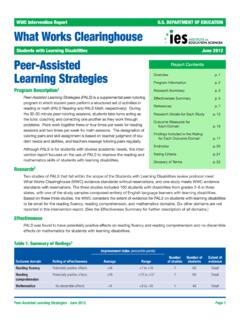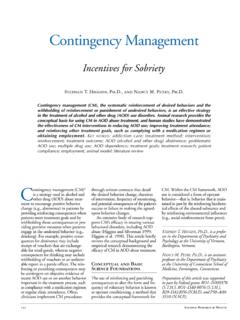Transcription of Examples of Evidence-Based Solutions to Increase Vaccine ...
1 Examples of Evidence-BasedSolutions to Increase VaccineConfidence and Uptake COVID-19 Vaccine Confidence: Rapid Community Assessment Department of Health and Human Services Centers for Disease Control and Prevention This table provides a list of Solutions /interventions to address specific issues identified by rapid community : What People Think and FeelPROBLEM AREASINTERVENTION CATEGORYAND DESCRIPTIONC ommunity members have low trust in vaccines. Community members do not feel that vaccines are safeor effective. Community members do not feel that vaccines are important for COVID-19 Educational campaign: a. Educational campaign consisting of informational posters with disease risk, letters, educational materials, group educational session highlighting disease salience and importance of Vaccine , posters encouraging vaccination to protect yourself1, 2 b.
2 Personalized education about vaccine3c. Employee health education in workplace settings4d. Decision aid that guides individual through vaccination decision-making process5 e. Health risk appraisal (assessing health risk behaviors and uptake of preventive care)6 f. TV/media ads to raise awareness about disease and response efficacy for a specific population ( , 65+ and 50+)7 2. Institutional recommendation: a. Institutions and workplaces encourage vaccination and provide vaccination stickers2,8,93. Not categorized: a. Vaccination campaign in a workplace or congregate setting consisting of a mandatory declination policy where HCWs sign a form saying they are declining the Vaccine and understand the risks of non-vaccination to themselves and others92 Domain: Social ProcessesPROBLEM AREASINTERVENTION CATEGORYAND DESCRIPTIONC ommunity lacks strong social norm emphasizing On-site vaccination: convenient access to and affordability of Vaccine by providing vaccination on site or at workplace42.
3 Institutional recommendation: a. Institutions and workplaces encourage vaccination and provide vaccination stickers2,8,93. Not categorized: a. Institutions and workplaces encourage vaccination and provide vaccination stickers9,10 Domain: Practical IssuesPROBLEM AREASINTERVENTION CATEGORYAND DESCRIPTIONC ommunity experiencing barriers to accessing the vaccine1. On-site vaccination: a. Increasing vaccination access with vaccination offered near hospital/clinic entrances9b. Increasing Vaccine accessibility in work site/high traffic areas8c. Vaccination at clinics, conferences, and house staff lounges11d. Increasing accessibility ( , mobile carts, during night and weekend shifts)1, 4e. Offer an option of getting vaccinated at home122. Free/Affordable Vaccines: a. Free vaccines, free vaccination services2, 4, 1,3, 143 Domain: What People Think and FeelPROBLEM AREASINTERVENTION CATEGORYAND DESCRIPTIONC ommunity members have low trust in vaccines.
4 Community members do not feel that vaccines are safeor effective. Community members do not feel that vaccines are important for COVID-19 Educational campaign: a. Educational campaign consisting of informational posters with disease risk, letters, educational materials, group educational session highlighting disease salience and importance of Vaccine , posters encouraging vaccination to protect yourself1, 2 b. Personalized education about vaccine3, 12, 16 c. Employee health education in workplace settings1-42. Reminders and recall a. Letter, telephone, and email reminders11,15-17 b. Walk-in clinics14,16 c. Patient outreach for reminder and assistance with follow-up and appointments16 3. Message Framing:a. Messaging that emphasizes the disadvantages of not getting vaccinated18 b. Letters/messaging that emphasize vaccination norms (that most people get vaccinated)19 4.
5 Incentivesa. Incentives for vaccination, including free lunches, raffles, lottery tickets, and cash prizes4b. Monetary incentives for vaccination9,20 5. Institutional Recommendationa. Institutions and workplaces encourage vaccination and provide vaccination stickers, thereby creating an institutional norm to get vaccinated2, 9-11 6. Vaccine champions:a. Vaccine champions: Influential figures get vaccinated and promote vaccination15 4 Acknowledgement: Dr. Erin James, Dr. Amyn Malik, and Dr. Saad Omer from Yale University, Institute for Global Health carried out the review of evidence on behavioural interventions to Increase uptake of adult vaccination. References1. Bryant KA, Stover B, Cain L, Levine GL, Siegel J, Jarvis WR. Improving influenza immunization rates among health-care workers caring for high-risk pediatric patients. Infect Control Hosp Epidemiol.
6 2004;25 Mustafa M, Al-Khal A, Al Maslamani M, Al Soub H. Improving influenza vaccination rates of healthcare workers: a multipronged approach in Qatar. East Mediterr Health J. 2017;23:303-10. 3. Arthur AJ, Matthews RJ, Jagger C, Clarke M, Hipkin A, Bennison DP. Improving uptake of influenza vaccination among older people: a randomised controlled trial. Br J Gen Pract. 2002;52:717-8, 20-2. 4. Sand KL, Lynn J, Bardenheier B, Seow H, Nace DA. Increasing influenza immunization for long-term care facility staff using quality improvement. J Am Geriatr Soc. 2007;55:1741-7. 5. Chambers LW, Wilson K, Hawken S, Puxty J, Crowe L, Lam P-P, et al. Impact of the Ottawa Influenza Decision Aid on healthcare personnel s influenza immunization decision: a randomized trial. J Hosp Infect. 2012;82:194-202. 6. Dapp U, Anders JA, von Renteln-Kruse W, Minder CE, Meier-Baumgartner HP, Swift CG, et al.
7 A randomized trial of effects of health risk appraisal combined with group sessions or home visits on preventive behaviors in older adults. J Gerontol A Biol Sci Med Sci. 2011;66:591-8. 7. Wallace C, Corben P, Turahui J, Gilmour R. The role of television advertising in increasing pneumococcal vaccination coverage among the elderly, North Coast, New South Wales, 2006. Aust N Z J Public Health. 2008;32:467-70. 8. Jiang C, Whitmore-Sisco L, Gaur AH, Adderson EE. A quality improvement initiative to Increase Tdap (tetanus, diph-theria, acellular pertussis) vaccination coverage among direct health care providers at a children s hospital. Vaccine . 2018;36:214-9. 9. Drees M, Wroten K, Smedley M, Mase T, Schwartz JS. Carrots and sticks: achieving high healthcare personnel influ-enza vaccination rates without a mandate. Infect Control Hosp Epidemiol. 2015;36:717-24.
8 10. Gilardi F, Castelli Gattinara G, Vinci MR, et al. Seasonal influenza vaccination in health care workers. A pre-post inter - vention study in an Italian paediatric hospital. Int J Environ Res Public Health. 2018;15. 11. Ohrt CK, McKinney WP. Achieving compliance with influenza immunization of medical house staff and students. A randomized controlled trial. Jama. 1992;267:1377-80. 12. Arthur AJ, Matthews RJ, Jagger C, Clarke M, Hipkin A, Bennison DP. Improving uptake of influenza vaccination among older people: a randomised controlled trial. Br J Gen Pract. 2002;52:717-8, 20-2. 13. Oguz MM. Improving influenza vaccination uptake among healthcare workers by on-site influenza vaccination cam-paign in a tertiary children hospital. Hum Vaccin Immunother. 2019;15:1060-5. 14. Zimmerman RK, Nowalk MP, Ray-mund M, Tabbarah M, Hall DG, Wahrenberger JT, et al.
9 Tailored interventions to14. Increase influenza vaccination in neighborhood health centers serving the disadvantaged. Am J Public ;93 Abramson ZH, Avni O, Levi O, Miskin IN. Randomized trial of a program to Increase staff influenza vaccination inpri-mary care clinics. Ann Fam Med. 2010;8 Humiston SG, Bennett NM, Long C, Eberly S, Arvelo L, Stankaitis J, et al. Increasing inner-city adult influenzavaccina-tion rates: a randomized controlled trial. Public Health Rep. 2011;126(Suppl 2) Hull S, Hagdrup N, Hart B, Griffiths C, Hennessy E. Boosting uptake of influenza immunisation: a randomisedcon-trolled trial of telephone appointing in general practice. Br J Gen Pract. 2002;52 Nan X, Xie B, Madden K. Acceptability of the H1N1 Vaccine among older adults: the interplay of message framingand perceived Vaccine safety and efficacy. Health Commun. 2012;27 Yokum D, Lauffenburger JC, Ghazinouri R, Choudhry NK.
10 Letters designed with behavioural science increaseinfluen-za vaccination in Medicare beneficiaries. Nat Hum Behav. 2018;2 Tao L, Lu M, Wang X, Han X, Li S, Wang H. The influence of a community intervention on influenza vaccinationknowl-edge and behavior among diabetic patients. BMC Public Health. 2019;19
















